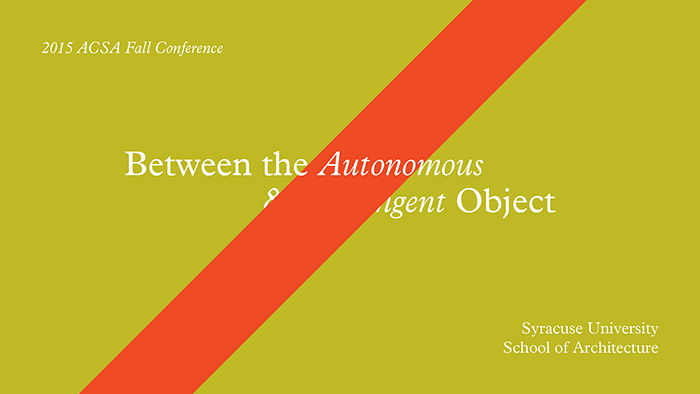Compiled and submitted by Edward R. Burian, Associate Professor, 1 Sept. 2015
Faculty News
Faculty in the Department of Architecture have recently published books, received design awards for built work, curated exhibitions, led innovative graduate design studios, and engaged in leadership roles in professional organizations.
Edward Burian, Associate Professor, has published his book, The Architecture and Cities of Northern Mexico from Independence to Present, (University of Texas Press, 2015) that explores the undervalued architectural culture of Tamaulipas, Nuevo León, Coahuila, Chihuahua, Durango, Sonora, Sinaloa, and Baja California Norte and Sur from 1821 to the present; and is the first overview of the region during this time period in English or Spanish. His introductory essay was also recently published in English and Spanish in, Reforma 27/Alberto Kalach, (Arquine and Editorial RM, Mexico City, 2015). He recently wrote two chapters for, Arquitectura de Coahuila a través del tiempo, (Biblioteca Milenio de Historia, 2015), that explores the architecture in Coahuila from the colonial era to the present and will be published in Spanish in full color and is co-sponsored by the government of the state of Coahuila. One chapter considers the representation of the public domain in terms of civic buildings, while the other discusses current and future directions for the architecture of Coahuila.
Ian Caine, Assistant Professor participated in the fall of 2014 in an exhibition titled To-Be-Destroyed (TBD) at The Museum of Contemporary Canadian Art (MOCCA) in Toronto, Ontario, CA. The museum featured his project titled Living Galleries alongside the work of dozens of artists and designers from around the world, including Gordon Matta-Clark (United States), Jeanne van Heeswijk (Rotterdam), and Jesse Harris (Toronto). The exhibition imagined new approaches and possible futures for the contemporary art gallery, emphasizing the potential of new museums to emerge as mutable — not fixed — entities. The Living Galleries proposal imagines the venue for the new museum as the city itself, with the first exhibition a history of suburban sprawl.
Dr. Sedef Doganer, Assistant Professor is the graduate advisor of record and Associate Dept. Head in the Department of Architecture. She recently published a book chapter titled, “New Hotel Design,” that will appear in, Tourism and Recreational Buildings,” published by VITRA Contemporary Architecture Series, (2013) in both English and Turkish. Among other grants, she has been awarded an interdisciplinary grant by San Antonio Convention & Visitors Bureau to study “State of San Antonio Heritage Resources” for approximately $30,000 annually with Prof. Bill Dupont and Dr. David Bojanic (College of Business).
Diane Hays, FAIA, Senior Lecturer and Interior Design Coordinator, received a 2012 San Antonio AIA Design Honor Award for her two UTSA Dept. of Architecture design-build studio projects at Bexar County’s Raymond Russell Park in San Antonio, TX.
Dr. Angela Lombardi, Assistant Professor has co-edited Lima, The Historic Center: Analysis and Restoration/ Centro Histórico. Conocimiento y restauración / Centro storico. Conoscenza e restauro, (Peru: Patrizia / Rome: Gangemi editore, 2012), that identifies and evaluates the endangered architectural heritage of Lima, Peru and was published in English, Spanish, and Italian.
Andrew Kudless of MATSYS in Oakland, CA http://matsysdesign.com/ was the Dean’s Distinguished 2014 Visiting Critic, teaching a graduate studio focusing on digital fabrication in which the studio designed, fabricated, and constructed a wood lattice structure in a park here in San Antonio, TX.
Kevin McClellan, former Adjunct Professor, was featured in Texas Architect, (March/April 2014) for his innovative work with TEX-FAB, http://www.tex-fab.net/, a nonprofit organization that connects professionals, students, and the Architecture, Engineering and Construction industry to advance the discipline of architecture in its adoption of digital fabrication. He currently works as a Project Architect for Marmon Mok in San Antonio.
Taeg Nishimoto, Professor, has researched and explored materials as well as their applications for site specific installations as well as product designs for lighting fixtures. Installations using fabric and lighting were presented as a part of the city of San Antonio’s public art program to liven the downtown street by staging a nightly performance in the empty storefront spaces. Other lighting product designs using fabric, papercrete and resin impregnated mesh fabric were featured in numerous international design websites, including evolo (US), Designstreet (Italy), Arthitectural (England), and Morfae (Greece). His prototype design for play furniture using the concrete impregnated fabric called CCpf has received a design copyright.
Dr. Antonio Petrov, Assistant Professor has recently lectured and participated in panel discussions at the Architectural Association (AA) in London, the Graham Foundation for Advanced Studies in Fine Arts in Chicago, the Chicago Architecture Foundation, and the Society of Architectural Historians (SAH) 67th Annual Conference in Austin, TX where he co-chaired a session on “Sacred Power: Religion, Politics and Architecture in the 20th Century.” His forthcoming book chapter, “Mediterranean Frontiers: Ontology of a Bounded Space in Crisis”, will appear in The Design of Frontiers: Control and Ambiguity published by Ashgate in July 2015. He has also published articles in journals and periodicals including, Arqa, ARRIS, Design Engine, Manifest, Mas Context and MONU. He is also currently working on an edited volume titled The City after the City to be published by Archeworks Papers, and a manuscript titled, Between Autonomy and Total Immersion in which he traces new forms of the secular in evangelical architecture in the United States. He was recently the Caudill Visiting Critic at Rice University, and the co-director of the Expander program, an interdisciplinary research think tank, at Archeworks in Chicago.
Dr. Hazem Rashed-Ali, Associate Professor and Associate Dean of Research and Graduate Studies was one of four UTSA faculty to receive the 2014 UT System’s Regents Outstanding Teaching Award awarded for extraordinary classroom performance and dedication to innovation. He was also a member of an interdisciplinary team of UTSA researchers to receive a $40,000 grant from the National Center for Preservation Technology and Training (NCPTT) to study of the energy efficiency and cost effectiveness of radiant barrier retrofits of historic homes in hot, humid climates, and also part of another interdisciplinary team of architecture and engineering faculty who received $16,500 from Harland Clarke Company to study continuous improvement and sustainability of their facilities. Recently, he was elected Vice President of the Architectural Research Centers Association (ARCC), an international association of schools of architecture and research centers committed to the expansion of the research culture and a supporting infrastructure in architecture and related design disciplines.
Candid Rogers, AIA, Adjunct Professor, recently had his residential project in Marfa, TX published in TX Architect. He also won a 2012 San Antonio AIA Design Award for his “Dos Diez” residential extension to an 1872 stone cottage in San Antonio, TX.
Javier Sánchez, design principal of the noted Mexico City architecture and development firm Jsa has a new book on the work of the firm, Urban Interlacing: Javier Sánchez, 2004-2013, (Arquine, 2014) published by the leading architectural press in Latin America. He was the initial Dean’s Distinguished Visiting Critic in the UTSA DOA for 2013, and his graduate studio at UTSA examined Colonia Atlampa, the last remaining parcel of underutilized urban land in the central core of Mexico City. The studio produced a group urban design proposal and individual mixed use infill projects.
A recent symposium and exhibit Walter Eugene George and the Cultural Legacy of the Rio Grande examined the work of retired UTSA faculty member Eugene George who passed away last year was held at the Institute for Texas Culture on Feb. 1st-28th 2014. George held the first San Antonio Conservation Society Endowed Professorship and during his career he generated some 500 drawings and 16,000 collected photographs focusing on the “Rio Grande Corridor” between Eagle Pass, TX and Brownsville, TX.

 Study Architecture
Study Architecture  ProPEL
ProPEL 










